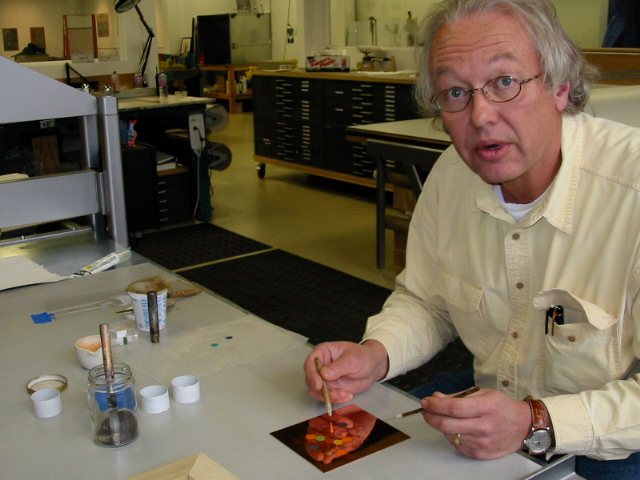
Born 1947, Evanston, Illinois
In 1966, Minneapolis’s Walker Art Center held its periodic “Biennial of Paintings and Sculpture” for Upper Midwest artists. The show attracted 1,385 submissions, of which 117 made it into the gallery. One of those was an abstract painting by twenty-year-old Stuart Nielsen. He had just started at the University of Minnesota in Minneapolis, which granted him a BFA in 1970. Soon he had a job at the Walker as an art installer. The work “was sort of graduate school for me,” he says.1 He met the Abstract Expressionists Robert Motherwell, Kenneth Noland, and Ellsworth Kelly, and was even asked to paint a group of Joan Miró’s bronze assemblages that had arrived straight from the foundry. That experience led to a lifelong affection for painted metal. Other early materials were guided by serendipity. He happened upon a hundred-pound bag of dental plaster in the basement of the Minneapolis building where he had a studio and mixed it with pigment. His work Transit (1973), featuring plaster imbedded with colorful squares, was in the 1975 Whitney Biennial at the Whitney Museum of American Art, New York. Later in that same basement Nielsen found a roll of thin, thirty-inch-wide fiberglass that, he discovered, took acrylic paint beautifully. (It was also useful for mending a crack in his ceiling.) On this he made large, decorative works depicting shell, fan, and circle motifs . He continued his penchant for unconventional materials with prints he created at Highpoint, published by Basic Content, in Minneapolis. Among the media used in North (cat. no. 211) , from the 2002 “Cardinal Suite,” are (the artist’s) blood, iron filings, saffron powder, and gold leaf.
A 1979 commission for an Oklahoma City shopping mall launched Nielsen on a twenty-year career creating—and advocating for—public art. While on the Minneapolis Arts Commission, he was instrumental in establishing the city’s Art in Public Places program. He was also among the group of artists who encouraged the Minneapolis Institute of Art to launch the Minnesota Artists Exhibition Program (MAEP), in 1975. “I have a streak of measured defiance,” he says. Among his public projects are Ten (2001) in Phillips, Wisconsin; Crucible (1995), near the University of Minnesota’s Amundson Hall; and Pacific Knot (1990), at Scripps Clinic, La Jolla, California. His work has appeared in “Layers of Time” (2019), Form + Content Gallery, Minneapolis; “From Beyond the Window” (2014), Katherine E. Nash Gallery, University of Minnesota, Minneapolis; “Glen Hanson Gallery: Then and Now” (2011), ArtOrg, Northfield, Minnesota; “Correspondence: The Art of Barbara Kreft and Stuart Nielsen” (2005–6), Rochester Art Center, Minnesota; “Decorative Abstractions” (1981) and “State: State of the Art/Art: Art of the State” (1975–76), Minneapolis Institute of Art; and “Invitation ’74” (1974), Walker Art Center, Minneapolis. Nielsen has received grants from the Minnesota State Arts Board (1982, 1980), Bush Foundation (1977), and Minnesota State Arts Council (1973). He lives in Minneapolis, his home since age three.
—Marla J. Kinney
Notes
Stuart Nielsen, phone conversations with the author, May 2020. ↩︎